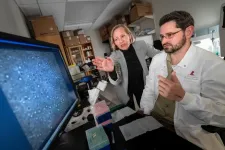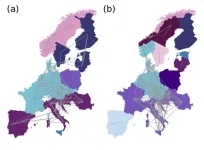(MEMPHIS, Tenn. – July 2, 2024) Biomolecular condensates are membraneless hubs of condensed proteins and nucleic acids within cells, which researchers are realizing are tied to an increasing number of cellular processes and diseases. Studies of biomolecular condensate formation have uncovered layers of complexity, including their ability to behave like a viscoelastic material. However, the molecular basis for this putty-like property was unknown. Through a multi-institution collaboration, St. Jude Children’s Research Hospital scientists examined the interaction networks within condensates to better define the rules associated with their unique material properties. Published in Nature Physics, the results quantify the timescales associated with these interactions, explaining why condensates act like a molecular putty and how they can “age” into a viscoelastic solid more akin to a rubber ball.
“Condensates have often been described as liquid-like, but their material properties can actually vary quite a bit,” explained co-corresponding author Tanja Mittag, PhD, Department of Structural Biology. “That depends on the sequences of the proteins within them and the lifetime of the interactions being formed.”
Interaction timescales define properties of condensates
The speed at which we interact with the world influences how the world responds. Hold putty in your hand, and it will eventually flow through your fingers. Throw it at a wall, and it will bounce back. The rules that govern this viscoelastic behavior are intrinsic to the interactions that occur within the putty, the making and breaking of which happen on a timescale encoded in the constituent molecules. This means if we interact with a material at different rates, the material will behave differently.
Biomolecular condensates act as reaction hubs to organize biomolecules in cells spatially. Their apparent abundance throughout cellular function and links to disease, particularly neurodegenerative diseases such as amyotrophic lateral sclerosis (ALS) and frontotemporal dementia, has brought with it fundamental questions that need answering. While garnering attention for their liquid-like behavior, such as their ability to flow, exchange material and dissolve as needed, their capacity to transition to more solid-like structures has led scientists to interrogate these fundamental material properties.
Through the St. Jude Research Collaborative on the Biology and Biophysics of RNP Granules, Mittag is leading work to understand how these material properties are determined by the amino acid sequence of the proteins that form the condensate. Current efforts build upon years of research into the “molecular grammar” of biomolecular condensates, the rules that dictate how molecules organize themselves through the process of phase separation.
Stickers-and-spacers are vital in viscoelastic crossroad
Mittag and her collaborators previously established a “stickers-and-spacers” model for predicting how proteins phase separate in work published in Science. “What we call ‘sticker’ amino acids make pairwise interactions that form a network fluid,” Mittag said. “Now we understand that these pairwise contacts that are forming — how stable they are and what their lifetime is — determine the viscoelastic properties of the condensates.”
The arrangement of stickers (amino acids that form contacts with other stickers) and spacers (amino acids necessary for patterning and arranging stickers and interactions with water) can predict phase-separating behavior in proteins. Now, the researchers found that whether the condensates behave as an elastic or viscous material depends on the strength of these sticker-sticker interactions.
“If we make stronger interactions, we can push their behavior more toward elastic properties. We now understand how this is encoded in the protein sequence,” said Mittag.
Biomolecular condensates age into viscoelastic solids
The group further probed how condensates age, changing their material properties over time. Prior work in the field focused on how proteins within aging condensates can arrange into fibrils, repeating patterns of proteins with a high degree of order. Fibril formation is linked to neurodegenerative diseases, such as ALS and frontotemporal dementia, but, as the researchers found, it is only one route along the aging pathway.
The researchers also identified an alternative path in condensate aging. “We found that if we exchanged spacer amino acids for ones that like to interact more with water, we could get condensates to age into a solid state, but it was not crystalline. It was not fibrils. Instead, it was a viscoelastic solid,” said co-first author Wade Borcherds, PhD, St. Jude Department of Structural Biology. “This is like putty becoming a rubber ball. They can both bounce, but one is solid, and one is not.”
“Condensate research helps us understand a lot of biology that has always existed in the cell but was not understood. This work puts this kind of biology on a quantitative, physical basis instead of treating it phenomenologically,” Mittag explained. “Now we know how these material properties and transitions are encoded within the protein sequence and how it really is a viscoelastic solid. That is, I think, the big breakthrough.”
Authors and funding
The study’s other co-first authors are Ibraheem Alshareedah, State University of New York at Buffalo; and Samuel Cohen, Washington University in St. Louis. The study’s other co-corresponding authors are Priya Banerjee, State University of New York at Buffalo; and Rohit Pappu, Washington University in St. Louis. The study’s other authors are Anurag Singh, State University of New York at Buffalo; Ammon Posey, Mina Farag, and Dylan Tomares, Washington University in St. Louis; Anne Bremer, St. Jude; and Gregory Strout, Washington University School of Medicine.
The study was supported by grants from the National Institutes of Health (R01NS121114, R35 GM138186 and T32 EB028092), the National Cancer Institute (P30 CA021765), the Children’s Discovery Institute of Washington University School of Medicine and St. Louis Children’s Hospital (CDI-CORE-2015-505 and CDI-CORE-2019-813), the Foundation for Barnes-Jewish Hospital (3770 and 4642) and ALSAC, the fundraising and awareness organization of St. Jude.
St. Jude Media Relations Contacts
Chelsea Bryant
Desk: (901) 595-0564
Cell: (256) 244-2048
chelsea.bryant@stjude.org
media@stjude.org
Rae Lyn Hartley
Desk: (901) 595-4419
Cell: (901) 686-2597
raelyn.rushing@stjude.org
media@stjude.org
St. Jude Children’s Research Hospital
St. Jude Children’s Research Hospital is leading the way the world understands, treats and cures childhood cancer, sickle cell disease and other life-threatening disorders. It is the only National Cancer Institute-designated Comprehensive Cancer Center devoted solely to children. Treatments developed at St. Jude have helped push the overall childhood cancer survival rate from 20% to 80% since the hospital opened more than 60 years ago. St. Jude shares the breakthroughs it makes to help doctors and researchers at local hospitals and cancer centers around the world improve the quality of treatment and care for even more children. To learn more, visit stjude.org, read Progress: A Digital Magazine and follow St. Jude on social media at @stjuderesearch.
END



